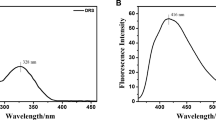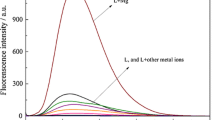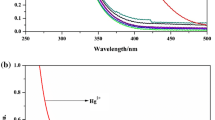Abstract
A novel probe, 3′,6′ - bis(diethylamino) -2- ((2,4-dimethoxybenzylidene)amino) spiro [isoindoline-1,9′-xanthene]-3-thione (RBS), was designed and synthesized. Its structure was characterized with elemental analysis, IR spectra and 1H NMR. The probe displayed highly selective and sensitive recognition of Hg2+. Reacting with mercury ions in aqueous solution, its fluorescence intensity was enhanced significantly, while its color was changed from colorless to pink. So, a new fluorescence method of detection of Hg2+ was proposed. Its dynamic response concentration range and detection limit for Hg2+ were 5.00 × 10−9 M to 1.00 × 10−6 M detected and 1.83 × 10−9 M, respectively. Satisfying results were obtained when the probe was applied to detect spiked Hg2+ in samples.










Similar content being viewed by others
References
Wolfe MF, Schwarzbach S, Sulaiman RA (1998) Effects of mercury on wildlife: a comprehensive review. Environ Toxicol Chem 17(2):146–160
Weiss B, Clarkson TW, Simon W (2002) Silent latency periods in methylmercury poisoning and in neurodegenerative disease. Environ Health Perspect 110(Suppl 5):851–854
Guallar E, Sanz-Gallardo MI, Veer P, Bode P, Aro A, Gómez-Aracena J, Kark JD, Riemersma RA, Martín-Moreno JM, Kok FJ (2002) Mercury, fish oils, and the risk of myocardial infarction. N Engl J Med 347(22):1747–1754
George GN, Prince RC, Gailer J, Buttigieg GA, Denton MB, Harris HH, Pickering IJ (2004) Mercury binding to the chelation therapy agents DMSA and DMPS and the rational design of custom chelators for mercury. Chem Res Toxicol 17(8):999–1006
Huang RJ, Zhuang ZX, Tai Y, Huang RF, Wang XR, Lee FSC (2006) Direct analysis of mercury in Traditional Chinese Medicines using thermolysis coupled with on-line atomic absorption spectrometry. Talanta 68(3):728–734
Llobet JM, Falco G, Casas C, Teixido A, Domingo JL (2003) Concentrations of arsenic, cadmium, mercury, and lead in common foods and estimated daily intake by children, adolescents, adults, and seniors of Catalonia, Spain. J Agric Food Chem 51(3):838–842
Dias Filho NL, do Carmo DR (2006) Study of an organically modified clay: selective adsorption of heavy metal ions and voltammetric determination of mercury (II). Talanta 68(3):919–927
Zejli H, Sharrock P, Hidalgo-Hidalgo de Cisneros JL, Naranjo-Rodriguez I, Temsamani KR (2005) Voltammetric determination of trace mercury at a sonogel–carbon electrode modified with poly-3-methylthiophene. Talanta 68(1):79–85
Wang M, Zhang Y, Feng WY, Guan M, Wang B, Shi JW, Zhu MT, Li B, Zhao YL, Chai ZF (2007) Determination of mercury in fish by isotope dilution inductively coupled plasma-mass spectrometry. Chin J Anal Chem 35(7):945–948
Fitzgerald WF, Gill GA (1979) Subnanogram determination of mercury by two-stage gold amalgamation and gas phase detection applied to atmospheric analysis. Anal Chem 51(11):1714–1720
Yoon S, Albers AE, Wong AP, Chang CJ (2005) Screening mercury levels in fish with a selective fluorescent chemosensor. J Am Chem Soc 127(46):16030–16031
Wanichacheva N, Setthakarn K, Prapawattanapol N, Hanmeng O, Sanghiran Lee V, Grudpan K (2012) Rhodamine B-based “turn-on” fluorescent and colorimetric chemosensors for highly sensitive and selective detection of mercury (II) ions. J Lumin 132(1):35–40
Ko SK, Yang YK, Tae J, Shin I (2006) In vivo monitoring of mercury ions using a rhodamine-based molecular probe. J Am Chem Soc 128(43):14150–14155
Wang L, Yan JX, Qin W, Liu W, Wang R (2012) A new rhodamine-based single molecule multianalyte (Cu2+, Hg2+) sensor and its application in the biological system. Dye Pigment 92(3):1083–1090
Yoon S, Miller EW, He Q, Do PH, Chang CJ (2007) A bright and specific fluorescent sensor for mercury in water, cells, and tissue. J Angew Chem Int Ed 46(35):6658–6661
Yang H, Zhou Z, Huang K, Yu M, Li F, Yi T, Huang C (2007) Multisignaling optical-electrochemical sensor for Hg2+ based on a rhodamine derivative with a ferrocene unit. Org Lett 9(23):4729–4732
Nolan EM, Lippard SJ (2007) Turn-on and ratiometric mercury sensing in water with a red-emitting probe. J Am Chem Soc 129(18):5910–5918
Liu J, Lu Y (2007) Rational design of “turn-on” allosteric DNAzyme catalytic beacons for aqueous mercury ions with ultrahigh sensitivity and selectivity. Angew Chem 46(40):7587–7590
Zhang D, Li M, Wang M, Wang J, Yang X, Ye Y, Zhao Y (2013) A rhodamine-phosphonate off-on fluorescent sensor for Hg2+ in natural water and its application in live cell imaging. Sensors Actuator B Chem 177:997–1002
Yapici NB, Jockusch S, Moscatelli A, Mandalapu SR, Itagaki Y, Bates DK, Wiseman S, Gibson KM, Turro NJ (2011) New rhodamine nitroxide based fluorescent probes for intracellular hydroxyl radical identification in living cells. Org Lett 14(1):50–53
Zheng H, Qian ZH, Xu L, Yuan FF, Lan LD, Xu JG (2006) Switching the recognition preference of rhodamine B spirolactam by replacing one atom: design of rhodamine B thiohydrazide for recognition of Hg (II) in aqueous solution. Org Lett 8(5):859–861
Lin WY, Cao XW, Ding YD, Yuan L, Yu QX (2010) A reversible fluorescent Hg2+ chemosensor based on a receptor composed of a thiol atom and an alkene moiety for living cell fluorescence imaging. Org Biomol Chem 8(16):3618–3620
Yang XF, Guo XQ, Zhao YB (2002) Development of a novel rhodamine-type fluorescent probe to determine peroxynitrite. Talanta 57(5):883–890
Benesi HA, Hildebrand JH (1949) A spectrophotometric investigation of the interaction of iodine with aromatic hydrocarbons. J Am Chem Soc 71(8):2703–2707
Acknowledgments
This work was supported by the National Nature Science Foundation of China (21175083).
Author information
Authors and Affiliations
Corresponding authors
Rights and permissions
About this article
Cite this article
Liu, S., Zhang, L., Gao, J. et al. Synthesis and Analytical Application of a Novel Fluorescent Hg2+ Probe 3′, 6′-Bis(Diethylamino)-2-((2,4-Dimethoxybenzylidene)Amino)Spiro[Isoindoline-1,9′-Xanthene]-3-Thione. J Fluoresc 23, 989–996 (2013). https://doi.org/10.1007/s10895-013-1225-7
Received:
Accepted:
Published:
Issue Date:
DOI: https://doi.org/10.1007/s10895-013-1225-7




